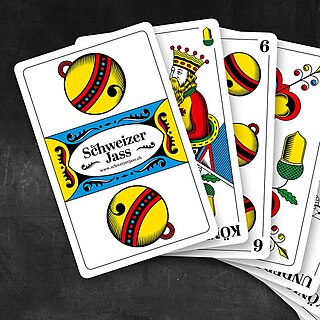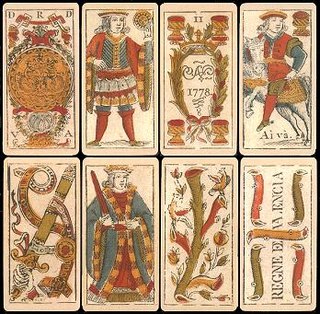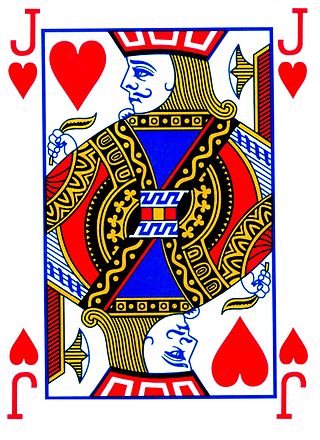
Pinochle, also called pinocle or penuchle, is a trick-taking, Ace-Ten card game typically for two to four players and played with a 48-card deck. It is derived from the card game bezique; players score points by trick-taking and also by forming combinations of cards into melds. It is thus considered part of a "trick-and-meld" category which also includes the game belote. Each hand is played in three phases: bidding, melds, and tricks. The standard game today is called "partnership auction pinochle".

Jass is a family of trick taking, Ace-Ten card games and, in its key forms, a distinctive branch of the Marriage family. It is popular in its native Switzerland as well as the rest of the Alemannic German-speaking area of Europe, Italian South Tyrol and in a few places in Wisconsin and Ohio, USA.
Ulti or Ultimó, is Hungary's national trick-taking card game for three players. It is virtually unknown outside its home borders.

Brisca is a popular Spanish card game played by two teams of two with a 40-card Spanish-suited pack or two teams of three using a 48-card pack.

Manille is a Catalan French trick-taking card game which uses a 32 card deck. It spread to the rest of France in the early 20th century, but was subsequently checked and reversed by the expansion of Belote. It is still popular in France and the western part of Belgium.

Sedma is a Czech 4-card trick-and-draw game played by four players in fixed partnerships with a 32-card Bohemian-pattern pack. Card suits do not play a role in this game, and there is no ranking order. A trick is won by the last player to play a card of the same rank as the card led.

Truc, pronounced [tʁy(k)] in France and [tɾuk] in Spain, is a 15th-century bluff and counter-bluff trick-taking card game which has been likened to poker for two. It is played in Occitania, Sarthe, Poitou (tru) and the Basque Country (truka), and is still very popular in the Valencia region. More elaborate versions are widely played in Argentina, Uruguay, Venezuela, Paraguay and Brazil under such names as Truco, Truque and Truquiflor. The French version Le Truc has become more widely known in the English-speaking world and among hobbyist gamers after Sid Sackson included it in his popular book A Gamut of Games (1969), it being a translation of E. Lanes' 1912 book, Nouveau Manuel Complet des Jeux de Cartes.

Reversis, or more rarely, Réversi, is a very old trick-taking card game of the Hearts group whose origin is supposed to be Italian, transformed into Spain and then in France. It is considered one of the two probable ancestors of Hearts, Black Lady and Black Maria, the other being Coquimbert or Coquinbert. It was very popular with the French aristocracy in the 17th and 18th centuries, and much played elsewhere, except in Britain. Initially quite simple, the game eventually developed into an elaborate affair involving vast quantities of counters and a complex system of pools and side-payments. Its name may have possibly come from the reverse order and construction of the game itself, or even from its exceptional slam which, like "shooting the moon" in Black Lady, reverses the entire aim of the game.
Clag is a trick-taking card game using a standard pack of 52 French-suited playing cards. It is similar to Oh Hell, and can be played by three to seven players. Clag originated in the British Royal Air Force and started as an acronym for Clouds Low Aircraft Grounded.

Bauerntarock also called Brixentaler Bauerntarock or Brixental Tarock, is a point-trick card game played in the Brixental, Austria. It may have originated in the 19th century either as an adaptation of 54-card Tapp Tarock onto the cheaper and smaller 36-card German pack. Another possibility is that it was adapted from the 78-card Grosstarock or Taroc l'Hombre game as the ratio of trumps to non-trumps is almost the same. It uses the Skat Schedule found in popular regional games such as Jass and Schafkopf. It is closely related to Bavarian Tarock, German Tarok, Württemberg Tarock and especially Dobbm. Like Bavarian Tarock and Tapp, Brixental Bauerntarock and Dobbm do not belong to the true tarot games, but have adopted rules from Tapp Tarock. The most fundamental difference between these games and true tarot games is in the use of German or French decks instead of true Tarot playing cards.

Gaigel is a card game from the Württemberg region of Germany and is traditionally played with Württemberg suited cards. It is a Swabian variant of Sechsundsechzig and may be played with 2, 3, 4 or 6 players. However, a significant difference from Sechsundsechzig and other related games like Bauernschnapsen is the use of a double card deck. The four-player game is usually called Kreuzgaigel. The game emerged in the early 19th century.

The card game of Bauernschnapsen is an expanded form of the popular Austrian card game of Schnapsen, played by four players. This variant of Schnapsen is played throughout the whole of Austria.

Dobbm or Tappen is a card game played in the Stubai valley in Austria and is one of a family of games derived from the Tarot game of Grosstarock by adapting its rules to a regular, shortened pack of 36 cards. The ranking and point value of the cards in Dobbm is typical of the family and, like its other members, one player always plays as a soloist against all the others. It is highly popular in the Stubai valley among card players of all generations, but is unknown in the surrounding regions.

Dreierschnapsen, Talonschnapsen or Staperlschnapsen is a three-hand variant of the popular Austrian card game, Bauernschnapsen. The rules are very similar to those for Bauernschnapsen except that, instead of two teams of two players, one player bids to become the soloist against the other two who form a temporary alliance. Another difference is that the game makes use of a talon with which the soloist may exchange cards to improve his hand, hence its alternative name of Talonschnapsen. The game is usually played with William Tell cards.

Zwanzigerrufen or Zwanz'gerrufen is the leading trick-taking card game of the Tarock family in many regions of eastern Austria. Its rules are simpler than the game of Königrufen which is more widely played in the whole of Austria. As is common in Tarock games, the cards have various point values – the primary goal in an individual game is to win the majority of points.
Zwanzig ab, 20 ab or simply Zwanzig is card game for four players. It is a member of the Rams family in which the key feature is that players may choose to drop out of the game if they believe their hand is not strong enough to take a minimum number of tricks. It appears to be a recent, internet-propagated variant of Schnalzen or Bohemian Watten. However, the latter has a natural card ranking, is played with double German cards and a Weli, has no exchanging and has a different scoring system. It is suitable for children from 8 upwards. It may be related from Fünf dazu! which is a simpler game described by Gööck in 1967 that has neither trumps nor the option to drop out.

Voormsi or Vorms is an old, Greenlandic, trick-taking card game of the Brusbart family designed for four players.

Call-ace Whist or Danish Whist is a card game for four players playing in variable partnerships. It is the most popular form of Whist in Denmark, where it is often just called "Whist". It has a well developed bidding system and has imported from the traditional Danish game of Skærvindsel the feature of determining the partnerships by 'calling an ace'. John McLeod records that there is also a version of Danish Whist in which there are fixed partnerships.

Sjavs is a Danish card game of the Schafkopf family that is played in two main variants. In Denmark, it is a 3-player game, played with a shortened pack of 20 cards; in the Faroe Islands, where it is very popular, it is a four-hand, partnership game using a standard Piquet pack of 32 cards.

1001 is a point-trick card game of German origin for two players that is similar to Sixty-Six. It is known in German as Tausendundeins and Tausendeins ("1001") or Kiautschou. The winner is the first to 1001 points, hence the name. Hülsemann describes the game as "one of the most stimulating for two players", one that must be played "fast and freely".
















